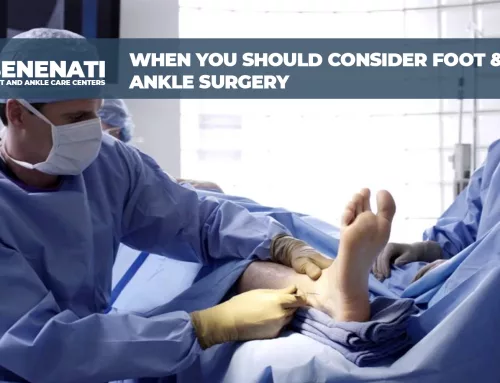Raynaud’s Disease
Raynaud’s Disease is a disorder that affects the hands and feet. It is caused by contraction of the smooth muscles controlling the small arteries supplying circulation into the hands and feet. This contraction, called a vasospasm, makes the arteries so small that they restrict blood flow. Exposure to cold temperature can often bring on a vasospasm.
Raynaud’s Disease has no known cause and is most common in young women. Staying warm and exercising regularly to maintain healthy blood circulation throughout the body can help offset the disease.
Sever’s Disease
Sever’s Disease, also known as calcaneal apophysitis, is a disease of the growth plate of the bone and is characterized by pain in the heel of a child’s foot, typically brought on by some form of injury or trauma. This condition is most common in children ages 10 to 15 and is frequently seen in active soccer, football, or baseball players. Sport shoes with cleats are also known to aggravate the condition. The disease mimics Achilles tendonitis, an inflammation of the tendon attached to the back of the heel. A tight Achilles tendon contributes to Sever’s Disease by pulling excessively on the growth plate of the heel bone (calcaneus).
Treatment includes cutting back on sports activities, calf muscle stretching exercises, heel cushions in the shoes, icing, and/or anti-inflammatory medications. Note: Please consult your physician before taking any medications.
Ollier’s Disease
Ollier’s Disease, also known as enchondromatosis, frequently occurs in the small bones in the hands and toes (phalanges) and the long bones behind the phalanges, called metatarsals. This condition is characterized by multiple enchondromas. Some form of injury or trauma to the toe results in the formation of the bony irregularity or prominence.
As with the majority of enchondromas, Ollier’s Disease generally requires no treatment. Only in cases where the tumors are aggressive and begin destroying bone tissue do they require further attention, often surgical removal.
Maffucci’s Syndrome
Maffucci’s Syndrome is a very rare form of enchondromatosis that combines multiple enchondromas in bones anywhere in the body with benign soft tissue tumors (known as hemangiomas), which are associated with blood vessels. This condition tends to appear in the hands and feet, and has a greater tendency toward malignant transformation than Ollier’s Disease.
Some form of injury or trauma to the toe results in the formation of this bony irregularity or prominence.
Maffucci’s Syndrome only requires treatment in cases where the tumors are aggressive and begin destroying bone tissue. In these cases, surgical removal is recommended.
Kaposi’s Sarcoma (AIDS related)
Kaposi’s Sarcoma is a cancerous lesion that can occur on the soles of the feet. The disease is usually associated with HIV infection and/or AIDS. The lesion is irregular in shape and has a purplish, reddish, or bluish-black appearance. Kaposi’s Sarcoma lesions tend to spread and form large plaques or become nodular. The nodular lesions have a firm, rubbery appearance.
Kohler’s Disease
Kohler’s Disease is a spontaneous loss of blood supply to a particular bone in the foot.
Treatments may include cast immobilization, reduced activities and foot orthotics or inserts.
Freiberg’s Disease
Freiberg’s Disease usually begins as a pain in the ball of a child’s foot. Its onset is often linked to an injury to the growth plate of one of the long bones behind the toes, called metatarsals. The loss of blood flow to the growth plate causes pain. Freiberg’s Disease is most frequently seen in adolescents between the ages of 13 and15. It is three times as likely to occur in females than in males.
Treatment for Frieberg’s Disease consists of reducing pressure under the affected bone. This may require the use of crutches and/or prescription of a custom orthotic.
Charcot Foot
Charcot Foot is a form of arthritis that often develops suddenly and without pain. Without any warning, the bones in the foot and/or ankle spontaneously fracture and fragment, often causing a severe deformity. The arch of the foot often collapses, and pressure areas develop on the bottom of the foot, leading to open sores or ulcers.
The average age of patients developing a Charcot Foot is 40 years. About one-third of patients develop a Charcot Foot in both feet and/or ankles.
Although nonsurgical treatments, such as elevation, icing, casts, and braces, can help alleviate pain and resolve open sores or ulcers, many of these deformities may require surgery to correct the fracture or remove bone fragments. This usually occurs in cases characterized by:
- Chronic deformity with increased plantar pressures and risk of ulcers.
- Chronic deformity with significant instability that cannot be corrected by braces.
- Significant deformity that may include ulcers that do not heal or respond to therapy.
Cancer
There are many kinds of cancers of the foot. Some take the form of cysts and lesions, while others are more widespread.
Malignant melanoma is a skin cancer that is curable if caught early. Although it makes up only one percent of skin cancers, malignant melanoma accounts for over 60 percent of skin cancer deaths. It is estimated that approximately 30 percent of melanomas occur in the lower extremities, and that 3 percent occur in the feet.
Neoplastic disorders, usually called tumors, are the result of abnormal growth of tissue. Both benign or malignant tumors occur in the foot.
Osteochondromas are benign bone tumors under the toenail. Osteochrondromas account for about half of all benign bone tumors in the foot, occurring mostly in children and young adults. Unless they cause irritation to the surrounding tissue, they are generally not very painful. Sometimes, they can deform the toenail and cause an ingrown toenail. In rare cases, they are removed surgically.
A plantar fibroma is a benign tissue tumor or growth on the plantar, or bottom surface of the foot. Unlike plantar warts, which grow on the skin, these grow deep inside on a thick fibrous band called the plantar fascia. There are a number of nonsurgical measures for treating plantar fibromas, such as orthotics. When these conservative measures fail to provide adequate relief of symptoms, surgical removal is a reasonable option.
Giant cell tumors are benign tumors of the tendon sheath. These masses are generally found on the toes, top of the foot, or sides of the foot. They can also occur deep inside the foot. They are firm irregular masses that are typically painful.





